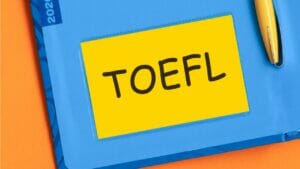Conducted by ETS (Educational Testing Service), TOEFL (Test of English as Foreign Language) is a globally accepted English proficiency test. The test assesses all 4 academic English skills, namely reading, listening, speaking and writing. TOEFL scores mirror non-English speaking candidates’ potential and ability to excel in English speaking universities.
Individuals willing to get admission to foreign universities can take the test in 2022 in any of three formats, TOEFL iBT, TOEFL at Home and the TOEFL paper-delivered test. They can find every detail about the TOEFL new format in the following sections.

TOEFL Exam Pattern 2022
As stated in the introductory paragraph, the TOEFL exam 2022 includes 4 sections, namely reading, listening, speaking and writing. Educational Testing Service (ETS) is responsible for deciding the exam pattern of TOEFL.
The following table shows the TOEFL new format of exam 2022.
[table id=249 /]
TOEFL iBT syllabus covers the reading, listening, speaking and writing attributes of the exam. TOEFL Exam Syllabus 2022
Here is a section wise detailed guide on the syllabus of the TOEFL new format.
TOEFL Reading Syllabus
- TOEFL reading test is the first step of four tier TOEFL test. The reading syllabus includes 3 – 4 passages of approximately 700 words.
- 10 questions are asked from each of these passages.
- The excerpts or reading passages are collected from university-level textbooks.
TOEFL Reading topics
TOEFL reading topic includes a variety of fields such as science, humanities, profession oriented, and social science.
Under these fields, numerous topics are covered. These are as follows:
- Physics
- Astronomy
- Public Relations
- Sociology
- Chemistry
- Art
- History
- Architecture
- Anthropology
- Biology
- Music
- Communication
- Political Science
- Geology
- Literature
- Technology
- Economics
- History
- Marketing
- Psychology
TOEFL Listening Syllabus
The listening test is the second part of the TOEFL examination. Its syllabus is bifurcated into two patterns, namely lecture and conversation.
- In the lecture portion, candidates have to listen to 3 – 4 lectures (each lecture can be 3 – 5 minutes long).
- Candidates have to answer 6 questions from each lecture.
- In the conversation segment, candidates have to listen to 2 or 3 conversations (3 minutes long each and can have 12 – 25 exchanges).
- Candidates have to answer 5 questions from each of these conversations.
- Listening questions can be categorized into 7 variants. These include detail, central idea, inference, organization, attitude, function, and categorizing.
TOEFL Listening Topics
Though providing exact listening topics of TOEFL can be a bit difficult. Candidates can expect the following examples:
- A conversation between a student and a university staff member, a professor, or a librarian.
- Lectures on usual university level topics.
TOEFL Speaking Syllabus
During the TOEFL speaking examination, candidates have to attempt two tasks. These are as follows:
- Integrated Speaking Task
TOEFL Integrated speaking test comprises 3 tasks (read/ listen/ speak).
Integrated Speaking Topics (Educational and campus-related questions)
- Keystone species
- Emotional intelligence
- Sports activities
- Admissions
- Hostels
- Registration details
- Housing
- Student activities
- Building improvement plans
Independent Speaking Task
Here, TOEFL candidates have to respond to 1 question or task from their own ideas, opinions or experiences.
Candidates will get 17 minutes to complete the task and 15 – 30 seconds for preparation before responding. They will have 45 – 60 seconds for each response.
Independent Speaking Topics
Independent speaking questions can come in a wide variety of types.
- Three choice questions
Example – Which of the following smartphone functions benefits students? a. taking photos b. listening to the music, c. recording lectures
- Preference question type
Example – Which one do you prefer? To purchase a newly-released e-product on the first day of launch or wait for some time and then decide whether you want to purchase it or not.
- Advantage or disadvantage type
Example – If a university plans to allow its students to watch TV in their dormitories, what will be your opinion, and why will you support it or not? What are the advantages and disadvantages of watching TV in dormitories?
- Agree or disagree question types
Example – Do you agree or disagree with the statement that female and male students must have separate residence halls in university?
- Description or explanation question type
Example – If police stop a driver and find out he or she is drunk, do you think police should seize the vehicle documents and driver’s license? Support your answer.
TOEFL Writing Syllabus
TOEFL writing syllabus comprises two sections, namely Integrated writing and Independent writing.
Integrated Writing Syllabus
In the Integrated writing section, candidates have to read a short passage in 3 minutes, listen to a short lecture in 2 minutes and then write (150 – 225 words) in 15 minutes. It means that to complete this section, students get a total of 20 minutes.
Integrated Writing Topics
- Television Appearances by University Professors (casting doubt)
- Great Houses
- Endotherms
- Online Encyclopedias
- Buying a Franchise
- Portrait of an Elderly Woman in a White Bonnet (casting doubt)
- Smart Cars
Independent Writing Syllabus
In this section, candidates have to answer 2 questions within 30 minutes.
Independent Writing Topics
Independent writing topics can come in one of the following four essay styles:
- Agree or Disagree
Example – Do you agree or disagree with the following statement? When people get success, it is because of their hard work. Here, luck has no importance at all. Use specific reasons and examples to explain your position.
- Multiple Choice
Example – Neighbors are the people who live next door or near us. In your opinion, what type of neighbour is ideal to have?
- Someone with whom our characteristics match
- Someone who is quiet
- Someone who is supportive
Use specific details and examples in your explanation.
- “Good Idea”
Example – Many people support the idea of opening shopping centres or areas near their homes.
Alternatively, there are other people who strongly oppose such ideas and the construction of such facilities. If you hear an announcement of the construction of a large shopping centre in your neighbourhood, will you support or oppose it? Use specific reasons and details to back your answer.
- Paired Choice
Example – There are certain people who prefer to live in a small town. On the other hand, there are others people who prefer to live in a big city. If you are given such an option, which place would you prefer to live in? Use specific reasons and details in response to your answer.
TOEFL Exam Score
The following table shows the TOEFL exam scores:
[table id=250 /]

Conclusion
TOEFL is accepted in 11,500 universities and institutions in over 160 countries. Thus by mastering the new format of TOEFL and syllabus, students can open a path to getting admission to prestigious universities across the globe and prove their English proficiency before examiners.
[faq-schema id=”8356″]







